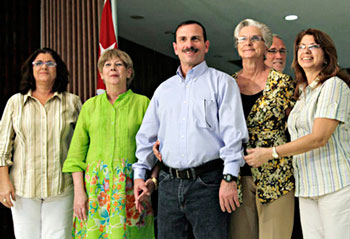(lead article)
Cuba welcomes return of
2nd revolutionary jailed in US

|
|
Cubadebate/Ismael Francisco
|
| Fernando González, center, on arrival in Havana airport Feb. 28 after more than 15 years in U.S. prisons. From left, his sister Marta González, wife Rosa Aurora Freijanes, mother Magali Llort and sister Lourdes González. He vowed to do “everything in my power” to win release of his three imprisoned comrades: Gerardo Hernández, Antonio Guerrero and Ramón Labañino.
|
BY MARTÍN KOPPEL
AND RÓGER CALERO
HAVANA — Fernando González received a hero’s welcome on his return home to Cuba Feb. 28. Millions across the island cheered the news as they saw him on TV shortly after his arrival here at José Martí International Airport. The next evening thousands poured into the streets of Havana to join him for a gala celebration, broadcast across the island, at which some of Cuba’s most popular musicians performed.
González was released Feb. 27 from the Federal Correctional Institution in Safford, Ariz., after serving his entire sentence of nearly 15 and a half years.
He and four other Cuban revolutionaries — Gerardo Hernández, Ramón Labañino, Antonio Guerrero, and René González — were framed up and railroaded to prison by Washington because of their actions to protect the people of Cuba from attacks by U.S.-based counterrevolutionary groups. They have won worldwide support in their fight for freedom. (See “Who Are the Cuban Five?” on page 5.)
González gave a military salute as he was greeted at the airport by Cuban President Raúl Castro and other government leaders. He was reunited with his wife Rosa Aurora Freijanes, his mother Magali Llort and his two sisters. They were accompanied by relatives of other members of the Cuban Five.
René González, who had been released from U.S. custody nearly a year ago, greeted him with a giant hug. It was the first time the two had seen each other since the five revolutionaries were sentenced in 2001 in a federal court in Miami.
In brief words to the press, Fernando González said that while he felt “an immense joy, there is a missing piece in that joy, and that piece will be filled when Ramón, Gerardo, and Tony are right here” with us.
Now that he is free, González said, “my role will be to do everything in my power to hasten that moment.”
Above all, he expressed thanks to his comrades in arms. In the initial two years they were locked up at the Miami Federal Detention Center — most of that time in punishment cells — “before a solidarity movement even existed, seeing them and sharing with them the difficult moments was always a source of energy for me in the struggle.”
He thanked the people and the revolutionary leadership of Cuba, “who have supported us in this struggle for so many years.”
Asked by a reporter how it felt to be released after 15 years in U.S. prisons, González said he only felt free when the plane landed in Cuba. Right up to that moment he had been kept in handcuffs by U.S. immigration, into whose custody he was transferred on leaving the Arizona federal prison for deportation to Cuba.
“It is we who are grateful to you,” said Cuban President Castro in welcoming Fernando, “especially because of the firmness you have demonstrated over so many years.”
The same day, the Cuban daily Granma published an extensive interview with González conducted by a group of online Cuban journalists via written questions and answers a few days before his release. “I feel satisfied that I fulfilled what I consider my duty with dignity and honor,” he told the reporters. “We know that in punishing us, they are trying to punish Cuba for the heresy of seeking to build a just society, and for doing so despite the hostility of the most powerful country on the planet, one that cannot accept the idea that Cuba is an independent and sovereign country.”
He said, “I simply did and have done what I’m sure millions of Cubans would have done” as the result of “our people’s history and spirit of struggle and resistance.”
The lesson the U.S. government should learn, he added, is that “just as they were unable to break the Five, they will never be able to destroy the revolution” in Cuba.
The five have been named Heroes of the Republic of Cuba by the Cuban government.
In a message sent from the Victorville federal prison in California, Gerardo Hernández — who is serving a double life sentence on trumped-up espionage and murder conspiracy charges — saluted Fernando for “coming out of prison with his head held high.” With his release, “our struggle is strengthened and reinforced by another standard-bearer” who now joins René González, he said (see Hernández’s message page 5).
That Saturday night a concert in support of the Five and celebrating Fernando González’s return was held on the steps of the main entrance to University of Havana. González and Yuniasky Crespo Baquero, first secretary of Cuba’s Union of Young Communists (UJC), briefly addressed the crowd of some 15,000. The concert, sponsored by the UJC and the Federation of University Students (FEU), featured top musical groups and artists such as Los Van Van, Yoruba Andabo and Vicente Feliú.
Related articles:
Minneapolis event celebrates return of Fernando González
Who are the Cuban Five?
‘Our struggle is reinforced by another standard-bearer’
Leadership from women was vital to Cuban Revolution
Showings of paintings by Antonio Guerrero
Cuban press covers presentations of new books on Cuban 5 at art studio, fair
‘No better way to open minds of people who have never heard the truth
about Cuban Revolution than to introduce them to our five brothers’
‘Experience of Five similar to that of millions of workers in US’
‘In prison, books helped us mature as Marxists’
| 


